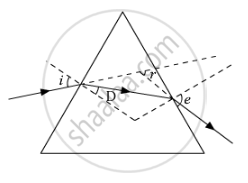Advertisements
Advertisements
प्रश्न
A beam of white light is shone onto a glass prism. The light cannot be:
(a) deviated
(b) dispersed
(c) focused
(d) refracted
उत्तर
focussed
A beam of white light when shone on to a glass prism can be deviated, dispersed or refracted, but it cannot be focussed.
APPEARS IN
संबंधित प्रश्न
After tracing the path of a ray of light through a glass prism a student marked the angle of incidence (∠i), angle of refraction (∠r) angle of emergence (∠e) and the angle of deviation (∠D) as shown in the diagram. The correctly marked angles are :

(A) ∠i and ∠r
(B) ∠i and ∠e
(C) ∠i, ∠e and ∠D
(D) ∠i, ∠r and ∠e
Fill in the blank with suitable word:
When a ray of light enters a prism, it bends ................ the normal ; as it leaves the prism, it bends ................. the normal.
What do you understand by the term spectrum? Name the various colours present in the spectrum of sunlight.
Explain the cause of dispersion of white light through a prism.
What conclusion do you draw about the nature of white light in part (b)?
The frequency range of visible light is from 3.75 × 1014 Hz to 7.5 × 1014 Hz. Calculate its wavelength range. Take speed of light = 3 × 108 m/s.
In which of the following four diagrams is the correct path of a ray of light passing through a glass prism shown ?
How can the presence of ultraviolet radiation be detected?
When sunlight passes through water droplets in the atmosphere it gets dispersed into its constituent colours forming a rainbow. A similar phenomenon is observed when white light passes through a prism.
Instead of sunlight, a green-coloured ray is passed through a glass prism. What will be the colour of the emergent ray?
